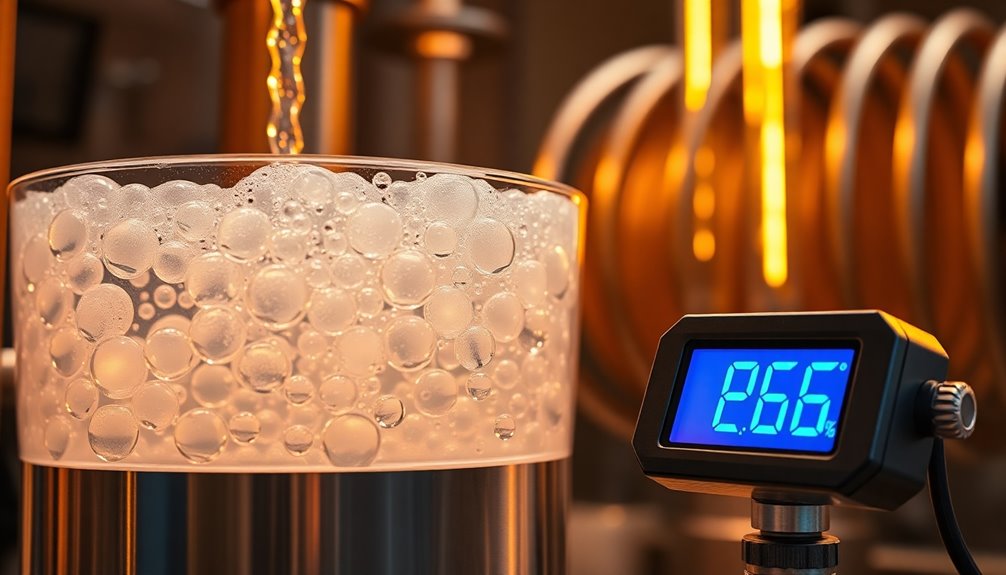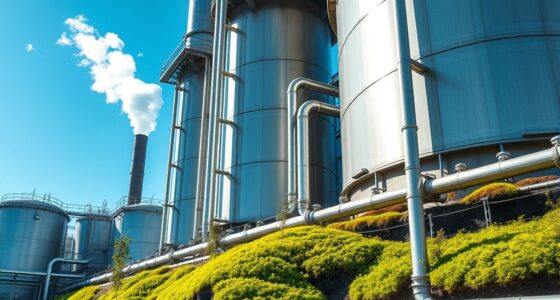When you revisit flow boiling heat transfer, you're looking at a blend of established theories and novel approaches. The interaction between liquid and vapor phases enhances heat transfer efficiency significantly. Key concepts like heat transfer coefficient and critical heat flux play vital roles in optimizing thermal management. Surface modifications and fluid properties also come into play, influencing bubble dynamics. By exploring these areas, you'll uncover practical applications that push the boundaries of thermal performance.
Key Takeaways
- Established theories of flow boiling emphasize the interplay between nucleate and convective boiling mechanisms in enhancing heat transfer efficiency.
- Novel approaches involve surface modifications that increase bubble nucleation sites and improve convective flow for better heat transfer performance.
- Understanding fluid properties is crucial, as different working fluids exhibit distinct bubble dynamics that affect overall heat transfer efficiency.
- The effects of mass flux and pressure on flow boiling regimes significantly impact heat transfer coefficient and thermal performance in practical applications.
- High-resolution visualization techniques are essential for studying bubble behavior and optimizing flow boiling systems across various industrial applications.

When you dive into the world of flow boiling heat transfer, you'll discover a fascinating interplay between liquid and vapor phases in a flowing fluid. Unlike pool boiling, which occurs in stagnant conditions, flow boiling thrives on the movement of the fluid, significantly influencing heat transfer efficiency.
Explore the dynamic interaction of liquid and vapor phases in flow boiling, where fluid movement enhances heat transfer efficiency.
You'll find that the performance of flow boiling is assessed using crucial parameters like the heat transfer coefficient (HTC) and critical heat flux (CHF), with CHF being particularly vital for maintaining system safety and efficiency.
In flow boiling, both nucleate and convective boiling mechanisms come into play. At lower vapor qualities, nucleate boiling dominates, where bubbles form and detach from surfaces. As you increase the heat flux, bubble dynamics change; you'll notice the departure frequency and diameter of bubbles increase.
This transition to convective boiling occurs at higher vapor qualities, where bulk flow enhances heat transfer through the movement of the fluid.
Surface modifications play a significant role in optimizing heat transfer in flow boiling. You'll find that structured surfaces increase bubble nucleation sites and promote convective flow, enhancing overall performance.
Different etching chemistries can lead to varied levels of heat transfer enhancement, while microscopic features impact how bubbles behave. The roughness of surfaces can affect bubble formation and departure diameter, making nanostructured surfaces an exciting area for advancing boiling heat transfer technologies.
Fluid properties also matter. Different working fluids exhibit unique bubble sizes and growth rates, influencing heat transfer efficiency. For instance, refrigerants often have smaller bubble sizes compared to water, requiring high-resolution visualization techniques to study their behavior accurately.
As you explore the effects of mass flux and pressure on flow boiling regimes, you'll gain insights into how these factors impact both HTC and overall thermal performance.
Frequently Asked Questions
What Materials Are Best for Flow Boiling Applications?
When considering materials for flow boiling applications, aluminum stands out due to its impressive heat transfer enhancements, reaching up to 391%.
Copper is also effective but offers lower enhancements, around 41%.
Incorporating nanomaterials can further boost performance by stabilizing nucleation sites.
You should also consider geometrical modifications, as micro- and nanostructured surfaces can significantly improve heat transfer efficiency.
Each of these materials and approaches plays a crucial role in optimizing flow boiling systems.
How Does Flow Boiling Differ From Pool Boiling?
Imagine two rivers: one flows smoothly, while the other sits still.
Flow boiling is like that flowing river, with forced circulation enhancing heat transfer through movement. Pool boiling, on the other hand, resembles the calm body of water, relying on natural convection.
In flow boiling, bubbles form and move rapidly, boosting heat transfer rates. Conversely, pool boiling's heat transfer is limited by stagnant conditions, making each method unique in efficiency and application.
What Industries Utilize Flow Boiling Heat Transfer?
Flow boiling heat transfer is crucial in various industries.
You'll find it in electronics for cooling high-performance devices, in power generation systems to manage heat, and in air conditioning for enhanced efficiency.
It's also vital in space exploration, ensuring thermal management in extreme conditions, and in transportation, where it aids machinery cooling.
Each of these applications relies on flow boiling to efficiently handle high heat fluxes and maintain optimal operational performance.
What Safety Concerns Exist With Flow Boiling Systems?
Imagine driving a car with a shaky wheel; that instability can spiral out of control.
In flow boiling systems, safety concerns arise from equipment malfunctions, thermal stress fluctuations, and premature critical heat flux.
These instabilities can lead to catastrophic failures, especially in nuclear contexts.
You need to monitor operational parameters closely and design systems to accommodate these risks, ensuring safety and efficiency in high-stakes environments.
How Can I Optimize Flow Boiling in My System?
To optimize flow boiling in your system, focus on enhancing surface modifications by integrating macro, micro, and nano features to improve heat transfer.
You should also consider advanced materials and emerging refrigerants, ensuring compatibility for optimal performance.
Implementing neural network models can refine your predictions, while real-time adaptive control strategies can dynamically adjust flow rates.
Lastly, visualize bubble dynamics to understand flow regime transitions and improve your system's efficiency.
Conclusion
In the intricate dance of flow boiling heat transfer, you've witnessed the blend of established theories and innovative approaches, like seasoned dancers learning new steps. As you navigate the practical applications, imagine harnessing this dynamic energy to optimize systems in ways that spark efficiency and innovation. Embrace the journey ahead, where each droplet of knowledge fuels progress, transforming challenges into opportunities, lighting the path toward a future where heat transfer is an art form in its own right.









